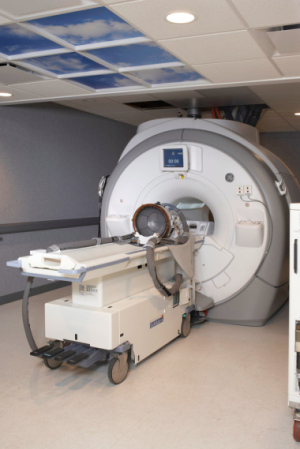Ultrasound: The go-to treatment for functional brain disorders?
by
Loren Bonner, DOTmed News Online Editor | September 19, 2013

ExAblate Neuro (Credit InSightec).
A noninvasive treatment for essential tremor, a disease characterized by shaky hands and limbs that affects roughly 10 million people in the U.S., may be closer to becoming a reality for patients.
The Israeli company InSightec Ltd. announced that the first patient has been treated with the ExAblate Neuro as of August when the Phase III study for the device began. The pivotal study, which is intended to lead to U.S. Food and Drug Administration approval of the device, will evaluate a large cohort of patients in eight sites around the world.
In many ways, the treatment has been a long time in the making for essential tremor patients. With guidance from an MR scanner, ExAblate is able to noninvasively direct high-intensity ultrasound waves to ablate a tiny portion of the brain circuit responsible for the tremor. Radiation treatment and surgery can currently treat essential tremor, but these options have drawbacks for many patients. Medication is also available, but drugs can vary in effectiveness.
Focused ultrasound, or the concept of directing high intensity ultrasound waves to a target, isn't all that new. Lars Leksell helped develop it in the 1950s to treat functional brain disorders but eventually abandoned the idea because it was hard to pinpoint the skull without advanced imaging, like MRI, which is key because the clinician needs to be able to image and test the target as well as measure the temperature during treatment. Leksell instead went on to invent the gamma knife in the late 1960s.
"Now we are coming full-cycle for these functional disorders where focused ultrasound will replace the gamma knife," Dr. Neal Kassell, founder and chairman of the Focused Ultrasound Foundation, told DOTmed News. The Focused Ultrasound Foundation was instrumental in funding the ExAblate study.
While the gamma knife is able to treat essential tremor noninvasively using the same target as the ExAblate would, some patients are reluctant to go through with radiation treatment because it can take up to three months before results appear. Another treatment option available for patients is something called deep brain stimulation. However, it's an invasive procedure where a pacemaker-type device is surgically implanted into the base of the patient's neck to control tremors. It also requires the patient to be awake for part of the procedure.
"Only 10 percent of people who would benefit ever get it," Dr. Karl Sillay, a neurosurgeon at Semmes-Murphey Neurologic & Spine Institute at the University of Tennessee, who is also a pioneer in deep brain stimulation, told DOTmed News. "They don't want to be awake, travel too far, they are scared, or they don't want their head shaved."
|
|
|
You Must Be Logged In To Post A Comment
|
